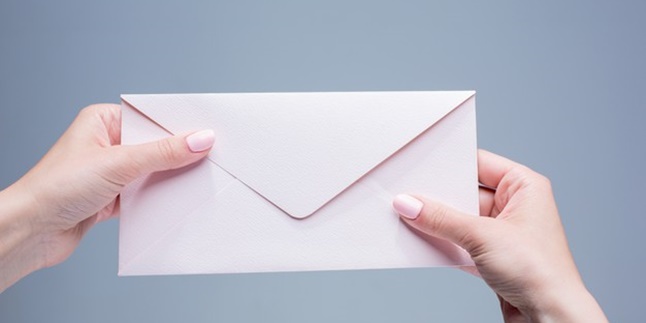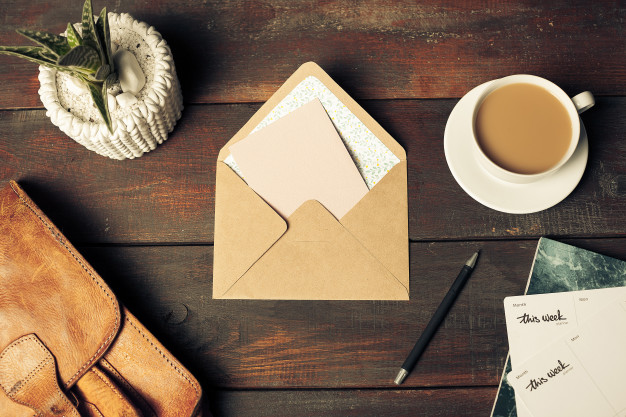13 Meanings of Being Given Money in Dreams, Is it a Good Sign?
Here are the meanings of being given money in dreams that can be a good sign or a bad sign. What are the meanings of these dreams? Let's check it out KLovers.

Kapanlagi.com - Technological advancements have made communication increasingly abandoned. However, letters can be one of the most effective means of delivering messages and bring their own sensations. Now, letter writing activities are commonly done in office environments. Writing personal letters has also become a rare thing to do. As a result, not many people recognize the characteristics of personal letters.
Before rapid technological communication like today, letters were one of the main means of sending messages for many people. Although now, people rarely send letters, it is still important to know the characteristics of personal letters as knowledge. Because, at any time, due to a certain condition, we may have to send a personal letter.
To understand the characteristics of personal letters more deeply, see the following reviews that have been summarized from various sources.

(credit: freepik)
In general, in the realm of correspondence, there are two types of letters, namely personal and official letters. Well, before knowing the characteristics of a personal letter, it is necessary for us to understand its definition first. A personal letter is one type of letter that is written and sent for personal purposes. Unlike official letters, which are written on behalf of an institution and usually for institutional or work purposes.
Because it is written for personal purposes, there are actually no definite rules or regulations in writing a personal letter. Everything depends on the sender of the letter. This means that the sender can write and convey messages in the letter freely or as they please. This includes the use of language, the writer is free to choose the language style according to the intended recipient of the letter.

(credit: freepik)
After understanding the definition of a personal letter, it is incomplete if we do not understand the
benefits of a personal letter. Just like modern communication media, personal letters certainly have their own benefits. By knowing the benefits of a personal letter, you will also find it easier to identify the characteristics of a personal letter. The benefits of a personal letter include:
1. Communication Medium
Before advanced communication technology like today, letters have been one way to communicate. The same goes for personal letters, which are commonly used by two people who have emotional closeness, such as family, relatives, friends, and so on, to exchange news and information.
2. Expression Medium
In addition to being a means of communication, a personal letter can also be used by someone as a medium of expression. Through a personal letter, someone can express their emotions or feelings to the recipient of the letter.
Furthermore, to understand what a personal letter is like, it can be seen from several characteristics or traits. The characteristics of personal letters are as follows.
1. There is no letterhead or header.
2. No need for a letter number.
3. Use casual or non-formal language (adjusted to the intended recipient of the letter).
4. Use greetings that are more personal, especially in the opening and closing parts.
5. There is no specific format, or in other words, the writing depends on the reader's reference.

(credit: freepik)
As mentioned earlier in the characteristics of personal letters, this type of letter actually does not have a specific format. However, personal letters still cannot be written haphazardly. This is because, in personal letters, there are several important parts of the structure. The structure of personal letters is as follows.
1. Origin Address and Date of Writing the Letter
The origin address and date of writing the letter are usually written in the top corner, either right or left. The address is written briefly, as well as when the letter was written briefly, for example, the name of the city or village depends on the writer's choice.
2. Opening Greeting
The opening greeting is the second part in a personal letter. Opening greetings become a way to start communication. It is not uncommon for people to use greetings and the question "how are you?" as an opening greeting.
3. Opening Paragraph
After opening with greetings, the next part is the opening paragraph. This paragraph is not an introduction to the story or the main message to be conveyed in the letter.
4. Main Paragraph
The main paragraph is the main part of a personal letter. This part can be a story, a message, or anything the sender wants to convey to the recipient. There are no restrictions on the number and length of the main paragraphs. It all depends on the message the sender wants to convey.
5. Closing Paragraph
After the entire message is conveyed in the main paragraph, the next is the closing paragraph. The closing paragraph is a way to end the letter. Usually, this part is accompanied by words that contain hopes, apologies, and other things.
6. Closing Greetings
The last part is the closing greetings. This part contains greetings, similar to the opening greetings. However, the closing greetings are used to truly close the entire letter.
Those are some explanations about the understanding and characteristics of a personal letter. Hopefully useful and can add insight.
(kpl/psp)
Cobain For You Page (FYP) Yang kamu suka ada di sini,
lihat isinya
Here are the meanings of being given money in dreams that can be a good sign or a bad sign. What are the meanings of these dreams? Let's check it out KLovers.
Fainting generally occurs because blood flow to the brain is disrupted or blocked. However, there are other triggering factors, here are the causes of fainting that need to be known.
In men, hair loss often occurs in old age, which can sometimes lead to baldness. So do you know what causes hair loss in men? Some of the reasons below may be the answer.
Like other acts of worship in Islam, endowments also have various pillars that must be fulfilled. In addition, there are other things that Muslims need to know about endowments. Summarized from various sources, here is an explanation of the understanding of endowments.
Anyone can be at risk of experiencing hoarseness if there is a problem with the vocal cords. So why does hoarseness occur? Here are the causes of hoarseness that need to be understood.
There are many benefits of lime for the face that cannot be underestimated. What are they?
No one knows when natural disasters will occur. All forms of natural disasters are certainly detrimental to us and as humans, we cannot stop natural disasters. So, what are the various natural disasters that often occur in Indonesia?
Here are 16 benefits of Ambon banana for health and beauty that are rarely known. What are these benefits? Let's check them out KLovers.
Generally, the causes of underarm odor and the triggering factors can occur due to excessive sweat production. But what makes underarms often smell? The reasons below might be the answer.
How to naturally get rid of acne scars with easily accessible household ingredients. Curious about how to naturally get rid of acne scars? Let's directly check out the complete review below.
There are various types of norms divided into four categories: religious norms, etiquette norms, legal norms, and moral norms. Here is a more detailed explanation of the types of norms and their sanctions in social life. Read the following review.
Here are 70 touching words for Fajr prayer in worship. Let's check them out, KLovers.